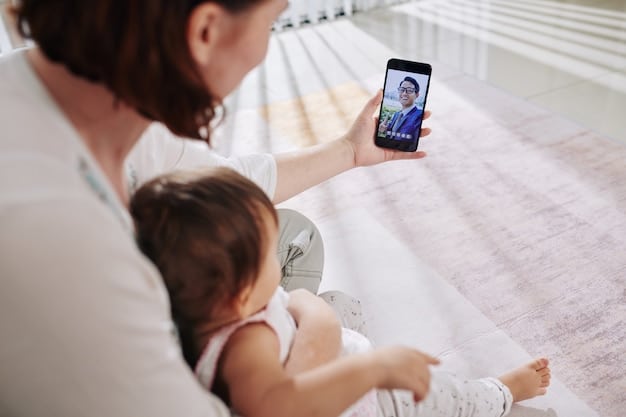Telehealth for Pediatric Care: Improved Access and Convenience

Telehealth for pediatric care enhances access and convenience for families by offering remote consultations, reducing travel time, and providing timely medical advice, especially beneficial for those in underserved areas or with mobility constraints.
Telehealth for pediatric care is revolutionizing how families access healthcare for their children. It offers a convenient, efficient way to connect with healthcare providers from the comfort of home, addressing many traditional barriers to care.
Understanding Telehealth for Pediatric Care
Telehealth involves using technology to deliver healthcare services remotely. For pediatric care, this means virtual appointments with pediatricians, specialists, and other healthcare professionals, allowing children to receive medical advice and treatment without needing an in-person visit.
This innovative approach is transforming how families manage their children’s health, providing a flexible and accessible alternative to traditional office visits. By leveraging video conferencing, mobile apps, and other digital tools, telehealth is making healthcare more convenient and efficient for busy families.
Benefits of Telehealth in Pediatric Care
Telehealth offers numerous advantages for both families and healthcare providers. These benefits range from increased accessibility to cost savings, making it an attractive option for pediatric care.
- Improved Access: Telehealth removes geographical barriers, allowing families in rural or underserved areas to connect with specialists who might otherwise be inaccessible.
- Convenience: Virtual appointments eliminate the need for travel, reducing time off work or school and minimizing disruption to daily routines.
- Cost Savings: Telehealth can lower healthcare costs by reducing transportation expenses, childcare costs, and the need for facility-based care.
- Timely Care: Telehealth enables prompt access to medical advice, which can be particularly important for urgent but non-emergency situations.
Telehealth enhances healthcare accessibility, convenience, and cost-effectiveness for families while ensuring the provision of timely and high-quality pediatric care.

Expanding Access to Specialized Pediatric Services
One of the significant advantages of telehealth is its ability to expand access to specialized pediatric services. Many families, especially those in rural areas, struggle to find specialists who can provide the care their children need.
Telehealth bridges this gap by connecting families with specialists regardless of their location. This is particularly beneficial for children with rare conditions or chronic illnesses that require specialized care.
Telehealth and Pediatric Specialists
Telehealth enables pediatric specialists to reach a broader patient base, offering consultations, diagnoses, and treatment plans remotely. This can significantly improve outcomes for children who would otherwise face long wait times or travel distances to see a specialist.
- Remote Consultations: Specialists can conduct virtual consultations to assess a child’s condition and provide recommendations to their primary care physician.
- Collaborative Care: Telehealth facilitates communication and collaboration between specialists and primary care providers, ensuring coordinated care.
- Follow-Up Care: Virtual follow-up appointments allow specialists to monitor a child’s progress and make adjustments to treatment plans as needed.
Telehealth significantly extends the accessibility of specialized pediatric care services, enhancing treatment options and improving healthcare results for children across diverse geographical locations.
The Convenience Factor: Balancing Family Life and Healthcare
For busy families, convenience is a critical factor when it comes to healthcare. Telehealth offers unparalleled convenience by eliminating the need for time-consuming and often stressful trips to the doctor’s office.
Virtual appointments can be scheduled at times that work best for the family, reducing the impact on work, school, and other commitments. This is particularly valuable for parents with multiple children or those who live far from medical facilities.
Integrating Telehealth into Daily Routines
Telehealth easily integrates into daily routines, making it easier for families to prioritize their children’s health. Virtual check-ups, medication management, and behavioral health support can all be accessed from the comfort of home.
- Flexible Scheduling: Telehealth appointments can be scheduled around school, work, and other commitments.
- Reduced Travel Time: Virtual visits eliminate the need to factor in travel time, saving families valuable hours.
- Home Comfort: Children may feel more comfortable and relaxed in their own environment during a telehealth appointment.
Telehealth offers a convenient means for families to balance their healthcare duties with the demands of life, fostering better health outcomes for children through its seamless integration into daily life.

Telehealth for Managing Common Childhood Ailments
Many common childhood ailments can be effectively managed through telehealth. From minor illnesses to chronic conditions, virtual appointments can provide timely and appropriate care.
Telehealth enables healthcare providers to assess symptoms, offer diagnoses, and recommend treatment plans remotely. This can prevent unnecessary trips to the emergency room and ensure that children receive the care they need when they need it.
Conditions Commonly Treated via Telehealth
Telehealth is well-suited for managing a variety of pediatric conditions, including respiratory infections, skin rashes, allergies, and behavioral health issues. Virtual appointments can be used for routine check-ups, medication refills, and follow-up care.
By leveraging technology, healthcare providers can offer comprehensive care for common childhood ailments, improving outcomes and enhancing the overall healthcare experience for families.
Addressing Behavioral and Mental Health Through Telehealth
Behavioral and mental health are critical aspects of pediatric care, and telehealth offers a valuable tool for addressing these needs. Virtual therapy sessions, counseling, and psychiatric evaluations can be conducted remotely, providing children with access to mental health services regardless of their location.
Telehealth can reduce the stigma associated with mental health treatment and make it easier for families to seek help for their children. This is particularly important in underserved areas where mental health resources may be limited.
Benefits of Telehealth for Mental Health
Telehealth offers several benefits for addressing behavioral and mental health in children. Virtual therapy sessions can be more convenient and accessible, allowing children to receive ongoing support without disrupting their daily routines.
- Increased Access: Telehealth expands access to mental health professionals, especially for children in rural areas.
- Reduced Stigma: Virtual therapy sessions can reduce the stigma associated with mental health treatment.
- Convenient Care: Telehealth appointments can be scheduled at times that work best for the family, making it easier to prioritize mental health.
Through overcoming obstacles and enabling convenient care, telehealth significantly elevates the delivery of emotional and mental healthcare for children, encouraging earlier involvement and holistic wellbeing.
The Future of Telehealth in Pediatric Care
The future of telehealth in pediatric care looks promising, with ongoing advancements in technology and increasing acceptance among families and healthcare providers. As telehealth becomes more integrated into the healthcare system, it has the potential to transform how children receive medical care.
From remote monitoring to AI-powered diagnostic tools, telehealth is poised to play an increasingly important role in improving the health and well-being of children.
Emerging Technologies in Telehealth
Several emerging technologies are set to enhance telehealth in pediatric care. These include wearable devices, remote monitoring systems, and AI-powered diagnostic tools. These technologies can provide healthcare providers with real-time data and insights, enabling them to deliver more personalized and effective care.
- Wearable Devices: Wearable devices can track vital signs, activity levels, and sleep patterns, providing valuable data for healthcare providers.
- Remote Monitoring Systems: Remote monitoring systems can be used to monitor chronic conditions, such as asthma and diabetes, allowing healthcare providers to intervene early if problems arise.
- AI-Powered Diagnostics: AI-powered diagnostic tools can assist healthcare providers in making more accurate diagnoses, improving outcomes for children.
Technological innovations are expected to drive the progression of telehealth in pediatric care, facilitating tailored and efficient consultations, thereby substantially improving the provision of healthcare for children.
| Key Point | Brief Description |
|---|---|
| 🌍 Increased Access | Telehealth expands healthcare access, especially in rural areas. |
| ⏱️ Convenience | Virtual appointments save time and reduce travel stress. |
| 💰 Cost-Effective | Telehealth reduces costs related to travel and childcare. |
| ❤️ Mental Health | Telehealth offers accessible mental health support for children. |
Telehealth for pediatric care involves using digital technologies to provide healthcare services to children remotely, including virtual appointments and remote monitoring.
Telehealth eliminates geographical barriers, allowing children in rural or underserved areas to connect with specialists, improving timely access to necessary care.
Telehealth reduces travel time, offers flexible scheduling, and allows children to receive care from home, making it easier for busy families to manage healthcare needs.
Yes, telehealth provides virtual therapy sessions and counseling, offering accessible mental health care and reducing stigma for children and families in need of support.
Telehealth uses video conferencing, mobile apps, wearable devices, and remote monitoring systems to deliver comprehensive and personalized care to children remotely.
Conclusion
Telehealth for pediatric care is transforming the healthcare landscape, providing families with improved access, increased convenience, and cost-effective solutions. By leveraging technology, telehealth is making it easier for children to receive the care they need, when they need it, regardless of their location or circumstances. As telehealth continues to evolve, it has the potential to revolutionize pediatric care and improve the health and well-being of children everywhere.





